Big Data refers to exceptionally large and complex datasets that traditional data processing tools cannot efficiently handle. These datasets are characterized by their vast volume, high velocity, and diverse variety, often referred to as the 3Vs of Big Data. Simply put, Big Data encompasses information so extensive and intricate that specialized technologies and approaches are required to store, process, and analyze it effectively.
Unlike traditional databases, which are optimized for handling structured data in organized formats like rows and columns, Big Data extends its reach to include semi-structured (e.g., XML, JSON) and unstructured data (e.g., images, videos, social media posts). The scale, speed, and diversity of Big Data demand distributed computing systems and advanced tools for processing and analysis, enabling organizations to uncover meaningful insights from vast amounts of information.
Big Data goes beyond traditional data systems in its ability to handle complex, large-scale problems. For example, it powers applications such as personalized healthcare, fraud detection in financial transactions, predictive analytics in marketing, and real-time traffic management. Specialized tools like Hadoop, Spark, and cloud-based platforms are designed to handle these datasets, enabling businesses to derive actionable insights and drive innovation.
The Five “Vs” of Big Data
The concept of Big Data is often defined by its five key characteristics, known as the Five “Vs”: Volume, Velocity, Variety, Veracity, and Value. These dimensions help explain what makes Big Data unique and challenging to manage, yet highly valuable for driving innovation and decision-making.
1. Volume
Volume refers to the enormous size of datasets that qualify as Big Data. These datasets are often measured in terabytes, petabytes, or even exabytes. The sheer scale of data comes from sources like social media platforms, IoT devices, e-commerce transactions, and multimedia content. For example, companies like Google and Facebook handle petabytes of user data daily. Managing such large volumes requires advanced storage solutions, distributed systems, and cloud computing platforms to ensure efficient data handling.
2. Velocity
Velocity describes the speed at which data is generated, collected, and processed. In today’s hyperconnected world, data streams in real-time from sources such as financial markets, IoT sensors, and online interactions. For instance, streaming platforms like Netflix analyze viewer data in real-time to recommend content. High velocity necessitates fast processing tools like Apache Kafka and Spark, which enable real-time analytics and decision-making.
3. Variety
Variety highlights the diverse formats and types of data within Big Data ecosystems. These include:
- Structured Data: Organized data, such as rows in a database.
- Semi-Structured Data: Data with partial organization, like JSON or XML files.
- Unstructured Data: Data with no fixed format, such as images, videos, and social media posts.
This variety poses challenges for traditional data management systems, requiring tools like Hadoop and NoSQL databases to accommodate different formats.
4. Veracity
Veracity refers to the accuracy, quality, and reliability of data. Big Data often includes inconsistencies, duplicates, or inaccuracies that can compromise analysis. For example, social media data may include spam or biased information. Ensuring data veracity requires robust data cleansing techniques, validation processes, and algorithms that minimize noise and errors. Reliable data is crucial for drawing meaningful and actionable insights.
5. Value
Ultimately, the most important “V” is Value. Extracting actionable insights from Big Data is the end goal, as this transforms raw data into a strategic asset. For example, predictive analytics can help businesses forecast customer behavior, optimize inventory, or improve healthcare outcomes. Tools like Tableau and Power BI assist in visualizing data, making complex insights accessible and actionable.
Sources of Big Data
Big Data is generated from a wide variety of sources, reflecting the interconnected and digitized nature of modern life. These sources contribute to the massive, diverse datasets that organizations analyze to gain valuable insights.
1. Social Media Platforms: Platforms like Facebook, Twitter, Instagram, and LinkedIn are major contributors to Big Data. They generate vast amounts of user-generated content, including posts, likes, shares, comments, and multimedia uploads. This data is often used for sentiment analysis, targeted advertising, and market research.
2. IoT Devices and Sensors: The Internet of Things (IoT) generates real-time data through devices and sensors embedded in various environments. Smart devices, wearable fitness trackers, industrial machinery sensors, and smart home systems continuously stream data. This information is crucial for applications like predictive maintenance, energy optimization, and real-time monitoring.
3. E-Commerce Transactions: E-commerce platforms like Amazon and eBay produce extensive data on customer behavior, transaction histories, product searches, and reviews. This data is invaluable for personalization, inventory management, and sales forecasting.
4. Enterprise Systems and Databases: Organizations generate and store data through enterprise systems such as CRM (Customer Relationship Management) platforms, ERP (Enterprise Resource Planning) systems, and financial databases. These systems track customer interactions, business operations, and financial transactions, forming the backbone of business intelligence strategies.
How Big Data Works?
Big Data operates through a structured process that enables organizations to collect, store, and analyze massive datasets for actionable insights. This workflow generally involves three main stages: Integration, Management, and Analysis.
1. Integration
The first step in Big Data processing is collecting data from diverse sources and consolidating it into a centralized repository. These sources include social media platforms, IoT devices, enterprise databases, and e-commerce systems. Data integration tools like Apache Nifi, Talend, or cloud-based services streamline the process, ensuring that structured, semi-structured, and unstructured data are ingested seamlessly.
2. Management
Once data is collected, it must be stored and organized efficiently. Big Data storage solutions like Hadoop Distributed File System (HDFS), Apache Spark, or cloud platforms such as AWS, Google Cloud, and Microsoft Azure enable scalable and secure data management. These tools ensure that data remains accessible for real-time processing or batch analysis. Proper management also includes data cleaning, where errors and inconsistencies are removed to enhance accuracy.
3. Analysis
The final step involves analyzing the data to extract meaningful insights. Advanced analytics techniques such as machine learning, predictive analytics, and natural language processing are used to uncover patterns, trends, and correlations. For example, businesses might use machine learning algorithms to predict customer behavior, optimize supply chains, or identify fraud. Visualization tools like Tableau or Power BI help present insights in an understandable format for decision-makers.
Use Cases of Big Data
Big Data has transformed industries by enabling smarter decision-making and innovation through data-driven insights. Here are some key examples of how different sectors leverage Big Data:
1. Healthcare: In the healthcare industry, Big Data is used to analyze patient records, genetic data, and real-time health monitoring from wearable devices. Predictive analytics helps identify potential health risks, enabling early intervention. For example, hospitals use Big Data to predict patient admission rates, allocate resources effectively, and improve personalized treatment plans.
2. Retail: Retailers utilize Big Data to understand customer behavior and preferences. E-commerce platforms like Amazon analyze purchase histories and browsing patterns to offer personalized product recommendations. Additionally, Big Data optimizes inventory management by predicting demand and preventing overstock or stockouts, ensuring efficient operations.
3. Finance: In the financial sector, Big Data plays a crucial role in detecting fraudulent activities by analyzing transaction patterns and identifying anomalies. Banks and credit institutions use predictive models to assess risks, improve credit scoring, and ensure compliance with regulations.
4. Marketing: Marketers leverage Big Data to segment audiences based on demographics, behavior, and preferences. This allows them to create highly targeted campaigns, optimize advertising budgets, and enhance customer engagement. Social media platforms and analytics tools enable brands to track campaign performance in real time, ensuring maximum ROI.
Challenges of Big Data
Despite its immense potential, Big Data comes with significant challenges that organizations must address to harness its value effectively.
1. Data Privacy and Security
Handling vast amounts of sensitive information raises concerns about data privacy and security. Organizations must comply with regulations like GDPR and CCPA to protect personal data and prevent breaches. Cybersecurity threats, such as data theft or unauthorized access, pose additional risks, making robust security measures essential.
2. Scalability
Managing the rapid growth of datasets is a significant challenge. As data volume and variety increase, traditional storage and processing systems often struggle to keep up. Organizations must invest in scalable solutions, such as distributed computing frameworks like Hadoop and Spark, to handle the growing demands of Big Data.
3. Cost
Implementing Big Data infrastructure can be expensive. High costs are associated with purchasing hardware, maintaining cloud storage, and investing in advanced analytics tools. Additionally, the expertise required to manage and analyze Big Data often involves hiring skilled professionals, further increasing expenses.
Conclusion
Big Data represents a transformative force in today’s world, offering unparalleled opportunities for innovation and efficiency. With its ability to analyze vast and complex datasets, Big Data provides valuable insights that drive decision-making across industries like healthcare, finance, retail, and marketing.
While it offers significant benefits, challenges such as data privacy, scalability, and cost must be managed effectively. As organizations continue to adopt Big Data technologies, their role in shaping modern industries and fostering innovation will only grow stronger.
Read More:
References:


